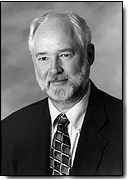 Message from the Head:
Message from the Head:
What has math done for me lately?
-Carl Cowen
As mathematicians, we are in a strange position with regard to the public at large: nearly every high school graduate has studied more "mathematics," in the form of arithmetic, algebra, etc., than any other school subject, yet most do not have any conception of math beyond what they have learned. Even well-educated college graduates are likely to see mathematics as consisting, in its entirety, of arithmetic, algebra, geometry (and trigonometry), and calculus. It is against this backdrop that our subject, and we, are judged.
We mathematicians have a difficult and important job to do in explaining to the public, to government, to employers, and even to other professionals what our subject is about and where it fits into their lives. Especially, we need to help the public understand what mathematicians have been doing since Newton and Leibnitz: most people cannot name any mathematical topic invented since 1800, with the possible exception of "chaos." Achievements in mathematics are rarely touted in the press until they approach the magnitude of the proof of Fermat's Last Theorem. This is in dramatic contrast with the situation in other sciences. Every educated person has heard of the Theory of Relativity, from early in the century, and of DNA, a discovery made in biology less than fifty years ago. Somewhat more esoteric, but still widely recognized, are string theory in physics and buckyballs in chemistry. With up-to-date information from other sciences and very little from mathematics, is it any wonder that most in the public conclude we have been doing nothing and presume that there is no math left to be discovered?
It is largely up to us to help the public and the professionals we work with learn of the existence and dynamic ongoing development of topics like group theory, topology, functional analysis, knot theory, algebraic geometry, analytic number theory, linear programming, stochastic differential equations, and so on. At the very least, we need consciously to let people know that, like the other sciences, the frontiers of mathematical knowledge are still moving forward and that there are libraries full of mathematics developed since calculus and high school algebra, even if they do not personally know of it. The American Mathematical Society's page (http://www.ams.org/new-in-math), the Mathematical Association of America's online columns (http://www.maa.org/news/columns.html), and the Association's magazine, Math Horizons, are good sources for news about mathematics.
Today, the lives of all citizens are touched more by the work of mathematicians than at any other time in history. Certainly, most in the public are unaware of this, and we need to help people make the connections. Much of the mathematics that influences us was developed as pure mathematics and was later taken "off the shelf" to be used to understand the world. The use of differential geometry in the theory of relativity, the use of group theory in understanding the symmetry of crystals and molecules, the use of functional analysis in producing the images in CAT scans, and the use of number theory in sophisticated encryption schemes are examples. Other fundamental work was undertaken to solve specific problems; the development of linear programming to solve optimization problems or the development of new algorithms in linear algebra to solve problems in signal processing are examples.
By far the most pervasive mathematical influence on our lives is the computer. Based on the work of Turing, von Neumann, and other mathematicians, the stored program computer took shape in the 1940's and 50's. By the 1960's some groups of mathematicians began to call themselves "computer scientists." The Purdue Computer Science Department, the first department in the U.S., was formed out of the Purdue Mathematics Department in the early 60's. While computer science is now distinct from mathematics, it is still very recognizably a mathematical science.
Purdue University is a "research university." This means that at Purdue, we provide a baccalaureate education for many students, we provide a research education for our graduate students, and we carry out the fundamental research that will shape our future. The mix of education and research produces stimulating teachers and researchers who can pass the latest discoveries in their fields to others. What has mathematics done for us lately? Look around! The mathematics of this century and earlier has shaped our world! What will it do for us in the future? The mathematical research of today and tomorrow will change the world in ways we do not yet know, but clearly it will not be less influential than it has been in the past. It will be important to do both applied research into such topics as the use of wavelets in solving problems in image compression more efficiently and pure research into such subjects as algebraic geometry which will have application in computer aided design. You can be sure that your department, the Purdue Mathematics Department, will continue to produce mathematicians and mathematical research that will play a leading role in the years to come.
|